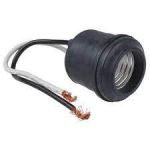TJenks048
Member
- Location
- West Virginia
- Occupation
- Commercial Electrician
Hi I'm Travis!
Just want to start off by saying that all my experience has been as a commercial electrician doing NEW WORK ONLY, so my experience is very limited as far as troubleshooting is concerned.
I am attaching an image of a sketch I did of the circuit so when I refer to something, you'll be able to know exactly what I'm referring to.
My breaker keeps tripping very randomly and inconsistently. Here are the steps I have taken so far. And this does not appear to be an overload problem, because it has tripped with nothing in the any of the receptacles being on. Also, since this is in the kitchen, when I refer to taking apart a receptacle, that also involves wire nutting the conductors together so the rest of the receptacles and lights could be used. And all of these boxes are plastic, so that can be eliminated as being a possible problem.
1) The first thing I did was replace the breaker. It tripped a short time after that.
2) So the next thing I wanted to do was check all the receptacles themselves. The first thing I did was start by taking receptacle #7 apart because it is the end of the run. It didn't have any signs of a loose connection and no burn marks. A while later, the breaker tripped.
3) Repeat of step 2 with receptacle #6
4) I opened the box to receptacle #4 and disconnected the wires that feeds receptacle #5 since it is for the dishwasher and I was trying to avoid taking the dishwasher out. A few hours later, the breaker tripped.
5) I then took receptacles #4 - #1 apart one at a time (I really thought it was going to be receptacle #2 since it is a GFCI). No signs of loose connections or burn marks. And after I took apart each of them, the breaker eventually tripped. So I had eliminated the receptacles themselves as being the problem.
6) I then took the double-gang switch box apart. All connections were tight and no signs of arching. I then disconnected the switches from the hots and disconnected the neutrals from the lights. I let it go for about a day, and the breaker DID NOT trip.
7) I tested continuity between hot-neutral and hot-ground on both switch legs, and one of them had continuity between the hot-neutral. I thought I had found the problem. So I connected the switch leg that tested good to the switch and left the bad one disconnected. But the next day the breaker tripped AGAIN.
8) I then disconnected the switch with the good switch leg. I then got really busy with my business, so I just left the switch legs disconnected for about 2 weeks, and the breaker didn't trip once. But then, with both switch legs disconnected, I was getting back to troubleshooting. I was about to take the boxes for the light fixtures apart, and the breaker tripped. The lights weren't even connected, just the receptacles.
So now, I'm sitting here scratching my head. The breaker is starting to trip more frequently now. I thought I had been thorough with my troubleshooting. I can only think of 2 things: 1) it's a conductor that's between the panel and the last receptacle that is very slightly damaged somehow, and occasionally arcs or 2) the conductor from the panel to receptacle #2 runs through the crawlspace and might have a junction box that I'm unaware of and there is a loose connection or there is water in the junction box.
Any help would be much appreciated because I'm at the end of my troubleshooting capabilities. ThanksView attachment 172504
Just want to start off by saying that all my experience has been as a commercial electrician doing NEW WORK ONLY, so my experience is very limited as far as troubleshooting is concerned.
I am attaching an image of a sketch I did of the circuit so when I refer to something, you'll be able to know exactly what I'm referring to.
My breaker keeps tripping very randomly and inconsistently. Here are the steps I have taken so far. And this does not appear to be an overload problem, because it has tripped with nothing in the any of the receptacles being on. Also, since this is in the kitchen, when I refer to taking apart a receptacle, that also involves wire nutting the conductors together so the rest of the receptacles and lights could be used. And all of these boxes are plastic, so that can be eliminated as being a possible problem.
1) The first thing I did was replace the breaker. It tripped a short time after that.
2) So the next thing I wanted to do was check all the receptacles themselves. The first thing I did was start by taking receptacle #7 apart because it is the end of the run. It didn't have any signs of a loose connection and no burn marks. A while later, the breaker tripped.
3) Repeat of step 2 with receptacle #6
4) I opened the box to receptacle #4 and disconnected the wires that feeds receptacle #5 since it is for the dishwasher and I was trying to avoid taking the dishwasher out. A few hours later, the breaker tripped.
5) I then took receptacles #4 - #1 apart one at a time (I really thought it was going to be receptacle #2 since it is a GFCI). No signs of loose connections or burn marks. And after I took apart each of them, the breaker eventually tripped. So I had eliminated the receptacles themselves as being the problem.
6) I then took the double-gang switch box apart. All connections were tight and no signs of arching. I then disconnected the switches from the hots and disconnected the neutrals from the lights. I let it go for about a day, and the breaker DID NOT trip.
7) I tested continuity between hot-neutral and hot-ground on both switch legs, and one of them had continuity between the hot-neutral. I thought I had found the problem. So I connected the switch leg that tested good to the switch and left the bad one disconnected. But the next day the breaker tripped AGAIN.
8) I then disconnected the switch with the good switch leg. I then got really busy with my business, so I just left the switch legs disconnected for about 2 weeks, and the breaker didn't trip once. But then, with both switch legs disconnected, I was getting back to troubleshooting. I was about to take the boxes for the light fixtures apart, and the breaker tripped. The lights weren't even connected, just the receptacles.
So now, I'm sitting here scratching my head. The breaker is starting to trip more frequently now. I thought I had been thorough with my troubleshooting. I can only think of 2 things: 1) it's a conductor that's between the panel and the last receptacle that is very slightly damaged somehow, and occasionally arcs or 2) the conductor from the panel to receptacle #2 runs through the crawlspace and might have a junction box that I'm unaware of and there is a loose connection or there is water in the junction box.
Any help would be much appreciated because I'm at the end of my troubleshooting capabilities. ThanksView attachment 172504





